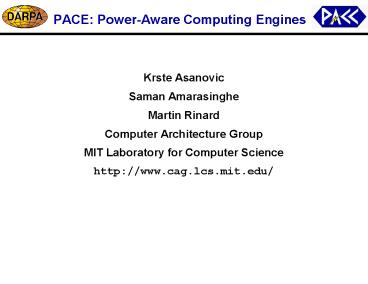PACE: Power-Aware Computing Engines PowerPoint PPT Presentation
Title: PACE: Power-Aware Computing Engines
1
PACE Power-Aware Computing Engines
- Krste Asanovic
- Saman Amarasinghe
- Martin Rinard
- Computer Architecture Group
- MIT Laboratory for Computer Science
- http//www.cag.lcs.mit.edu/
2
PACE Approach
Energy-Conscious Compilers
Rethink Hardware-Software Interface for
Power-Aware Computing
3
Conventional Architectures only Expose Performance
- Current RISC/VLIW ISAs only expose hardware
features that affect critical path through
computation
4
Energy Consumption is Hidden
- Most energy is consumed in microarchitectural
operations that are hidden from software!
5
Energy-Exposed Instruction Sets
- Reward compile-time knowledge with
- run-time energy savings
- hardware provides mechanisms to disable
microarchitectural activity, a software power
grid - compile-time analysis determines which pieces of
microarchitecture can be disabled for given
application - Co-develop energy-exposed architectures and
energy-conscious compilers
6
Energy Management Layers
Application
Algorithm
Source Code
Compiler
Run-Time/O.S.
PACE Focus Areas
Instruction Set
Microarchitecture
Circuit Design
Fabrication Technology
7
SCALE Strawman Processor
- 32 processing tiles
- Fast on-chip data network
- 128x32b FLOP/cycle total
- 4096x8b OP/cycle total
- 128MB on-chip DRAM/16MB SRAM
- External DRAM interface
- Chip-to-chip interconnect channels
- 20x20mm2 in 0.1?m CMOS
I/O
Tile
Bulk SRAM/ Embedded DRAM
Addr. Unit
Data Unit
Cntl. Unit
SRAM/cache
Off-chip DRAM
Data Net
8
SCALE Processor Tile Details
9
SCALE Supports All Forms of Parallelism
- Vector
- most streaming applications highly vectorizable
- vectors reduce instruction fetch/decode energy
up to 20-60x (depends on vector length) - mature programming and compilation model
- SCALE supports vectors in hardware
- address and data units optimized for vectors
- hardware vector control logic
Vector Instructions
VLIW Program Counter
- VLIW/Reconfigurable
- exploit instruction-level parallelism for
non-vectorizable applications - superscalar ILP expensive in hardware
- SCALE supports VLIW-style ILP
- reuse address and data unit datapath resources
- expose datapath control lines
- single wide instruction configuration
- provide control/configuration cache distributed
along datapaths
- Multithreading/CMP
- run separate threads on different tiles
- any mix of vector or VLIW across tiles
10
SCALE Exposes Locality at Multiple Levels
- 2D Tile and DRAM layout
- software maps computation to minimize network
hops - Local SRAM within tile
- software split between instruction/data/unified
storage - software scratchpad RAMs or hardware-managed
caches - Distributed cached control state within tile
- control unit instruction buffer
- data/address unit vector instructions or
VLIW/configuration cache - Distributed register file and ALU clusters within
tile - Control Unit scalar (C) registers versus branch
(B) registers - Address Unit address (A) registers
- Data Unit Four clusters of data registers
(D0-D4) - Accumulators and sneak paths to bypass register
files
11
SCALE Software Power Grid
- Turn off unused register banks and ALUs
- Reduce datapath width
- set width separately for each unit in tile (e.g.,
32b in control unit, 16b in address unit, 64b in
data unit) - Turn off individual local memory banks
- Configure memory addressing model
- From hardware cache-coherence to local scratchpad
RAM - Turn off idle tiles and idle inter-tile network
segments - Turn off refresh to unused DRAM banks
12
Existing Infrastructure
- RAW Compiler Technology
- SUIF-based C/FORTRAN compiler for tiled arrays
- SPAN pointer analysis
- Bitwise bitwidth analysis
- Superword Level Parallelism
- Space/Time scheduling
- MAPS compiler-managed memory system
- Pekoe Low-Power Microprocessor Library Cells
- Full-custom processor blocks in 0.25mm CMOS
process - Designed for voltage-scaled operation
- SyCHOSys Energy-Performance Simulator
- Fast, multi-level compiled simulation
- Energy models for Pekoe processor blocks
13
Bitwidth Analysis
- Compile-time detection of minimum bitwidth
required for each variable at every static
location in the program - A collection of techniques
- Arithmetic operations
- Boolean operations
- Bitmask operations
- Loop induction variable bounding
- Clamping optimization
- Type promotion
- Back propagation
- Array index optimization
- Value-range propagation using data-flow analysis
- Loop analysis
- Incorporated pointer alias analysis
- Paper in PLDI00
14
Bitwidth Power Savings(C?ASIC Synthesis)
- Methodology
- C ? RTL
- RTL simulation gives switching
- Synthesis tool reports dynamic power
- IBM SA27E process, 0.15?m drawn, 200 MHz
Base case
Bitwidth analysis
15
SyCHOSys Energy-Performance Simulation
- SyCHOSys compiles a custom cycle simulator from a
structural machine description - Supports gate level to behavioral level, or any
mixture - Behavior specified in C, compiles to C object
- Can selectively compile in transition counting on
nets - Automatically factors out common counts for
faster simulation - Arbitrary energy models for functional
units/memories - Capacitances extracted from circuit layout or
estimated - Use fast bit-parallel structural energy models
(much faster than lookups) - Paper in Complexity-Effective Workshop, ISCA00
16
SyCHOSys Evaluation
- GCD circuit benchmark
- full-custom datapath layout (0.25?m TSMC CMOS
process) - mixture of static and precharged blocks
17
SyCHOSys Processor Model
- Five-stage pipelined MIPS RISC processorcaches
- User/kernel mode, precise interrupts, validated
with architectural test suiterandom test
programs - Runs SPECint95 benchmarks
- Simulation speeds (Sun Ultra-5, 333MHz
workstation) - (ISA-level interpreter 3 MHz)
- Behavioral RTL 400kHz
- Structural model 40kHz
- Energy model 16kHz
- A Gigacycle/CPU-day or Megacycle/CPU-minute with
better accuracy than Powermill
18
PACE Milestones
- Year 2000 Baseline design
- Baseline SCALE architecture definition
- RAW compiler generating code for baseline SCALE
design - Baseline SCALE architecture energy-performance
simulator - Year 2001 Single tile
- Energy-exposed SCALE tile architecture definition
- Energy-conscious compiler passes for SCALE tile
- Energy-exposed SCALE tile energy-performance
simulator - Evaluation of energy-exposed SCALE tile
- Year 2002 Multi-tile
- Energy-exposed SCALE multi-tile architecture
definition - Multi-tile energy-performance simulator
- Multi-tile energy-conscious compiler passes
- Evaluation of multi-tile SCALE processor
- (Options Fabricate SCALE prototype)

